
Англ.мова
.pdfExercise 8. Use the words below to fill in the gaps. Each word will be used once.
Atomic number |
Mass number |
protons |
Electrons |
Isotope |
neutron |
1.The atomic number tells you how many __ and __ are in an atom.
2.The bold, whole number found on the periodic table is called the __. It is unique for each element.
3.The total number of protons and neutrons in an atom is called the __.
4.An atom with the same number of protons but different number of neutrons is called an __.
5.The subatomic particle that has no charge is called a __.
Exercise 9. Put questions to the following sentences. Use different types of
questions. Do this task in writing.
1)It was this discovery that enabled J. J. Thomson to complete his understanding of the generators of X-rays – the cathode rays or electrons.
2)It was Professor Johnson who delivered a lecture last week.
3)It is this theory that is of interest to us.
4)It was not until 1895 that Popov invented radio.
5)It was the student who helped us.
6)It was radioactivity that attracted the attention of scientists at the beginning of the XX-th century.
7)It was in the theory of light that the first discovery of the electron had raised difficulties.
Exercise 10. Say some words about the discovery of the atomic structure.
31
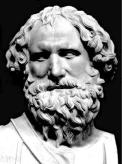
UNIT V. ARCHIMEDES OF SYRACUSE (HOME-READING)
Read the text and translate it into Ukrainian in writing.
Born: 287 BC in Syracuse, Sicily
Died: 212 BC in Syracuse, Sicily
Archimedes is considered one of the three greatest mathematicians of all time along with Newton and Gauss. In his own time, he was known as “the wise one,” “the master” and “the great geometer” and his works and inventions brought him fame that lasts to this very day. He was one of the last great Greek mathematicians.
Born in 287 B.C., in Syracuse, a Greek seaport colony in Sicily, Archimedes was the son of Phidias, an astronomer. Except for his studies at
Euclid‟s school in Alexandria, he spent his entire life in his birthplace. Archimedes proved to be a master at mathematics and spent most of his time contemplating new problems to solve, becoming at times so involved in his work that he forgot to eat. Lacking the blackboards and paper of modern times, he used any available surface, from the dust on the ground to ashes from an extinguished fire, to draw his geometric figures. Never giving up an opportunity to ponder his work, after bathing and anointing himself with olive oil, he would trace figures in the oil on his own skin.
Much of Archimedes fame comes from his relationship with Hiero, the king of Syracuse, and Gelon, Hiero‟s son. The great geometer had a close friendship with them and may have been related to the monarch. In any case, he seemed to make a hobby out of solving the king‟s most complicated problems to the utter amazement of the sovereign. At one time, the king ordered a gold
32
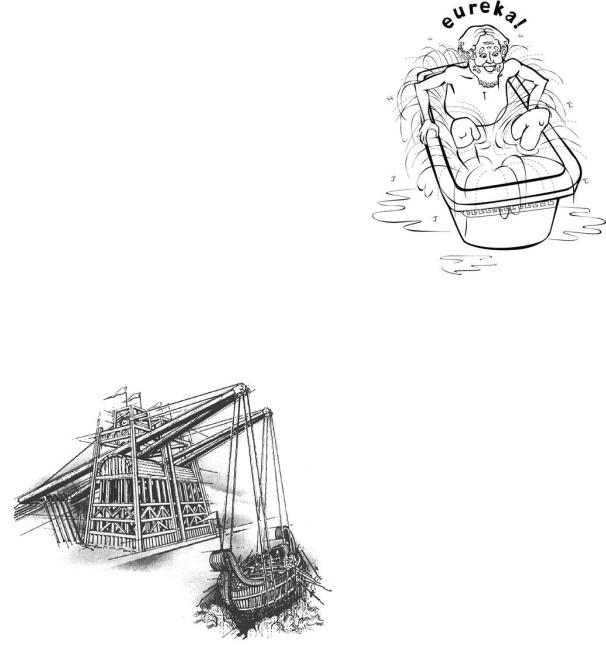
crown and gave the goldsmith the exact amount of metal to make it. When Hiero received it, the crown had the correct weight but the monarch suspected that some silver had been used instead of the gold. Since he could not prove it, he brought the problem to Archimedes. One day while considering the question,
“the wise one” entered his bathtub and recognized that the amount of water that overflowed the tub was proportional the amount of his body that was submerged. This observation is now known as
Archimedes‟ Principle and gave him the means to solve the problem. He was so excited that he ran naked through the streets of Syracuse shouting “Eureka! eureka!” (I have found it!). The fraudulent goldsmith was brought to justice. Another time, Archimedes stated “Give me a place to stand on and I will move the earth”. King Hiero, who was absolutely astonished by the statement, asked him to prove
it. In the harbor was a ship that had proved impossible to launch even by the combined efforts of all the men of Syracuse. Archimedes, who had been examining the properties of levers and pulleys, built a machine that allowed him the single-handedly move the ship from a distance away. He also had many other inventions including the
Archimedes‟ watering screw and a miniature planetarium.
33
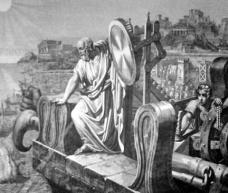
Though he had many great inventions, Archimedes considered his purely theoretical work to be his true calling. His accomplishments are numerous. His approximation of between 3-1/2 and 3-10/71 was the most accurate of his time and he devised a new way to approximate square roots.
Unhappy with the unwieldy Greek number system, he devised his own that could accommodate larger numbers more easily. He invented the entire field of hydrostatics with the discovery of the Archimedes‟ Principle. However, his greatest invention was integral calculus. To determine the area of sections bounded by geometric figures such as parabolas and ellipses, Archimedes broke the sections into an infinite number of rectangles and added the areas together. This is known as integration. He also anticipated the invention of differential calculus as he devised ways to approximate the slope of the tangent lines to his figures. In addition, he also made many other discoveries in geometry, mechanics and other fields.
The end of Archimedes life was anything but uneventful. King Hiero had been so impressed with his friend‟s inventions that he persuaded him to develop weapons to defend the city. These inventions would prove quite useful. In 212 B.C., Marcellus, a Roman general,
decided to conquer Syracuse with a full frontal assault on both land and sea. The Roman legions were routed. Huge catapults hurled 500 pound boulders at the soldiers; large cranes with claws on the end lowered down on the
enemy ships, lifted them in the air, and then threw them against the rocks; and systems of mirrors focused the sun rays to light enemy ships on fire. The Roman soldiers refused to continue the attack and fled at the mere sight of anything projecting from the walls of the city. Marcellus was forced to lay siege to the city, which fell after eight months. Archimedes was killed by a Roman
34

soldier when the city was taken. The traditional story is that the mathematician was unaware of the taking of the city. While he was drawing figures in the dust, a Roman soldier stepped on them and demanded he come with him. Archimedes responded, “Don‟t disturb my circles!” The soldier was so enraged that he pulled out his sword and slew the great geometer. When Archimedes was buried, they placed on his tombstone the figure of a sphere inscribed inside a cylinder and the 2:3 ratio of the volumes between them, the solution to the problem considered his greatest achievement.
35
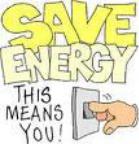
UNIT VI. ELECTRICITY AND MAGNETISM
Exercise 1. Listen to the text. State whether the following statements are true or
false.
1.Scientists have tested a radio that doesn‟t have wires inside it.
2.In another test, scientists lit 60 different light bulbs.
3.Scientists have sent electricity two metres through the air.
4.Wi-Fi is a concept that first originated at the end of last year.
5.The invention of WiTricity signals the end of vacuum cleaners.
6.WiTricity may reduce the number of household electrical fires.
7.An inventor struck upon the idea of WiTricity a hundred years ago.
8.Wireless offices and homes will be with us before the year is out.
Exercise 2. Read the text. Answer the following questions.
1.What could you say about long and legendary past of electricity?
2.When did magnetism and electricity appear as a science?
3.Why did electricity attract little attention during the Newtonian period?
4.Why was Stephen Gray‟s discovery of electricity transmission important for
science?
5.How did Franklin explain electrically charged bodies?
6.Could you draw the analogy between his explanation and the modern theory of electric charge?
7.What natural electrical phenomenon did Franklin explain and how did he use it in practice?
8.Why did electricity and magnetism still remain mysterious even after
Franklin‟s discovery?
36
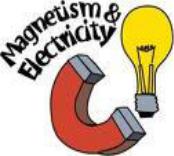
9.What discovery did Coulomb make?
10.Why was his discovery of great importance?
11.What did Oersted accidentally find?
12.Why was this discovery of great importance?
ELECTRICITY AND MAGNETISM
The first new science to arise after the end of the Newtonian period was electricity, in part because it was almost the only aspect of physical science to which Newton himself had not devoted his attention and where his great prestige did not frighten off lesser investigators. Electricity had had a long and legendary
past. The phenomena of electrostatics and magnetism were known to ancient men as early as 600 B.C. The ancient Greek philosophers thought magnetic and electric forces to be of common origin.
Science of magnetism, however, only began when its power could be used to good purpose, as in the compass. In its early stages, however, magnetism didn‟t seem to promise any profitable application. It was a philosophic toy and lay a little outside the interests of the time, which were turned so largely to mechanics and the vacuum.
Some experiments with electricity were made in the early eighteenth century. One of them was made by the English amateur Stephen Gray that led him in 1729 to a discovery of the transmission of electricity. Franklin, in remote Philadelphia heard of experiments with electricity and sent for some electrical apparatus. Having studied the problem Franklin came to the conclusion that electricity is a kind of immaterial fluid existing in all bodies, undetectable as long as they were saturated with it. If some was added, they became positively charged, if some was removed – negatively. Replacing the fluid by electrons
37
and changing the sign of the charge, – for +, for it is a negatively charged body that has an excess of electrons, Franklin‟s explanation becomes the modern theory of electric charge. This simplification was Franklin‟s serious contribution to electrical theory, but what really impressed the world was his understanding the analogy between electric spark of the laboratory and the lightning which he snatched from the sky with his kite and showed that it was electricity. From this he, in his practical way, immediately drew the conclusion that it would be possible to prevent the damage due to lightning by the lightning conductor which he tried out in 1753. With this invention electrical science became for the first time of practical use.
Despite all these advances electricity and magnetism remained mysterious and their quantitative study could not begin until some method could be found of measuring them. This was the work of Coulomb ['ku:ləm] in 1785. He established that the forces between magnetic poles as well as those between charges of electricity obeyed the same laws as those of gravity, that is, a force proportional inversely to the distance. These experiments enabled the whole apparatus of Newtonian mechanics to be applied to electricity, but with this difference: that in electricity repulsive as well as attractive forces to be found.
The multiple analogies between electricity and magnetism made physicists think that there must be some connection between them but it was one very difficult to find. It was not until 1820 that through another accident at the lecture table, Oersted in Copenhagen found that the electric current deflected a compass needle. He thus joined together, once and for all, the sciences of electricity and magnetism. One immediate consequence was the invention of the electromagnet, then the electric telegraph and the electric motor.
38
Exercise 3. You have read the text. Fill in the gaps. You can use information
from the text.
1.After the Newtonian period scientific interests mainly turned to ….
2.In the early 18th century Stephen Gray discovered ….
3.Soon after that Franklin discovered that all bodies are saturated with ….
4.With the excess of this fluid a body becomes ….
5.The first practical invention in the field of electricity was Franklin‟s ….
6.Scientific studies of electricity could begin only with Coulomb‟s discovery ….
7.The difference between the force of gravitation and those of
electromagnetism made scientists think that ….
Exercise 4. State whether the following statements are true or false. Explain
your choice.
1.Electricity was the first new science to arise after the end of the Newtonian period.
2.Electricity had had a long and legendary past.
3.The ancient Greek philosophers believed magnetic and electric forces to be of common origin.
4.In its early stages, magnetism seemed to promise some profitable application.
5.The experiment made by the English amateur Stephen Gray led to a discovery of the transmission of electricity.
6.Franklin drew a conclusion that it would be possible to prevent the damage due to lightning by the lightning conductor.
7.Franklin established that the forces between magnetic poles as well as those between charges of electricity obeyed the same laws as those of gravity, that is, a force proportional inversely to the distance.
8.Oersted found that the electric current reflected a compass needle.
39
Exercise 5. Translate the following English terms into Ukrainian. Work in pairs: check up your memorizing of these word combinations.
Light conductor, heat conductor, pressure field, sound field, surface field, wave field, field force, gravity force, reaction force, attraction field, pressure field value, field force values; accelerating field, applied field, changing field, shielded conductor, collecting field, controlling field, curved field, demagnetizing field, defocusing field, varying field.
Exercise 6. Translate the following Ukrainian terms on the base of English word „transmission‟ into English.
Теплопередача, звукопередача, пропускання світла, передача сигналів,
одностороння передача, механічна передача, двустороння передача,
розповсюдження тиску, пропускання ультрафіолетових променів.
Exercise 7. Write down English equivalents to the following Ukrainian word combinations from the text.
Мали спільне походження; на ранніх ступенях розвитку; поза інтересами;
зірвав з неба; надлишок електронів; попередити збиток, спричинений блискавкою; блискавковідвід; не дивлячись на усі успіхи;
підпорядковуються тим самим законам; обʼєднав раз і назавжди; стрілка компаса.
Exercise 8. Look through the text if necessary, and answer the question “What was the contribution of each of the mentioned scientists to the development of science of electricity and magnetism?”
40
